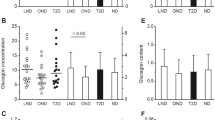Summary
The physicochemical nature and biological function of extrapancreatic immunoreactive glucagon in the plasma of totally pancreatectomized dogs were studied. The experimental animals were divided into two groups. Group A received only total pancreatectomy while group B had total pancreatectomy plus total gastrectomy. The blood was taken from both groups of dogs and glucagon was extracted using acid alcohol. The amount of IRG contained in the plasma extract was measured and the glycogenolytic activity of the plasma extract was studied using a rat-liver perfusion. The plasma extract from group A showed almost the same glycogenolytic activity as a commercial beef-pork glucagon but the plasma extract from group B manifested no glycogenolytic activity. The plasma from both groups were fractionated using column chromatography and their physicochemical nature was compared. The IRG in the plasma from group A was fractionated into 3 types, molecular weight 9000, 7000 and 3500, while the IRG in the plasma from group B was found to be of M. W. 9000 and 7000. These results lead to the following conclusions:
-
1)
Extrapancreatic IRG in the plasma is fractionated into three types.
-
2)
The glycogenolytic activity of extrapancreatic IRG is assumed to depend on the IRG fraction of molecular weight 3500.
-
3)
Most of the extrapancreatic IRG fraction of M. W. 3500 originates in the stomach.
Similar content being viewed by others
References
Vranic M., et al: Increased “Glucagon immunoreactivity” in the plasma of totally depancreatized dogs. Diabetes 23: 905, 1974
Murphy RF, et al: Isolation of glucagon like immunoreactivity of gut by affinitychromatography on anti glucagon antibodies coupled to Sepharose 4B. Biochem Biophys Acta 303: 118, 1973
Orci L., et al: Structural evidence for glucagon producing cells in the intestinal mucosa of the rat. Diabetelogia 4: 56, 1968
Sutherland EW, et al: Origin and distribution of the hyperglycemic glycogenolytic factor of the pancreas. J Biol Chem 175: 663, 1948
Ikei S, Mori K, et al: Effect of gastrectomy on glycogen metabolism in depancreatized dogs. Jpn J Gastroenterol (Proc of 64th Jpn Gastroenterol): 79, 1978
Sasaki M., et al: An ultra micro-colorimetric method for the determination of plasma glucose with Otoluidine boric acid. Clin Path 12: 434, 1964 (Jpn)
Unger RH, et al: Glucagon antibodies and their use for immunoassay for glucagon. Proc Soc Exp Biol Med 102:621, 1969
Valverde I., et al: Molecular size of extractable glucagon and glucagon like immunoreactivity (GLI) in plasma. Diabetes 19: 624, 1970
Kenny AJ, et al: Extractable glucagon of the human pancreas. J Clin Endocr 15: 1089, 1955
Mortimore GE, et al: Effect of insulin on release of glucose and urea by isolated rat liver. J Physiol 204: 699, 1963
Cherrington AD, et al: Arginine infusion in dogs. Model for the roles of insulin and glucagon in regulating glucose turnover and free fatty acid levels. Diabetes 23: 805, 1974
Matsuyama T., et al: Plasma glucose, insulin, pancreatic and enteroglucagon levels in normal and depancreatized dogs. Proc Soc Exp Biol Med 147: 97, 1974
Mashiter K., et al: Persistent pancreatic glucagon but not insulin response to arginine in pancreatectomized dogs. Endocrinology 96: 678, 1975
Morita S., et al: Measurement and partial characterization of immunoreactive glucagon in gastrointestinal tissues of dogs. Diabetes 25: 1018, 1976
Blazquez E., et al: Gastric A cell function in insulindeprived depancreatized dogs. Endocrinology 99: 1182, 1976
Baetens D., et al: Identification of glucagon-producing cells (A cells) in dog gastric mucosa. J Cell Biol 69: 455, 1976
Sasaki H., et al: Identification of glucagon in the gastrointestinal tract. J Clin Invest 56: 135, 1975
Valverde I., et al: Heterogeneity of plasma glucagon immunoreactivity in normal, depancreatized and alloxian diabetic dogs. Metabolism 24: 1021, 1975
Srikant CB, et al: Characteristics of tissue IRGs in the dogs. Metabolism 25: 1043, 1976
Author information
Authors and Affiliations
Additional information
This work was supported by Grant in Aid for Scientific Research (248257 for 1977) from the Ministry of Education, Japan.
Rights and permissions
About this article
Cite this article
Ikei, S., Mori, K., Sakamoto, Y. et al. The physicochemical nature and biological function of extrapancreatic immunoreactive glucagon. Gastroenterol Jpn 15, 241–246 (1980). https://doi.org/10.1007/BF02774274
Received:
Accepted:
Issue Date:
DOI: https://doi.org/10.1007/BF02774274




